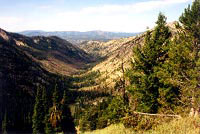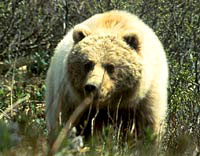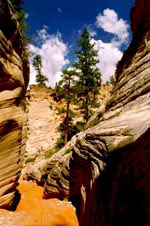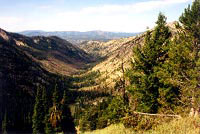
Roadless and fancy-free.
Photo: U.S. Forest Service.
As the Clinton administration rushes to complete its lands legacy agenda in the American West, two methods of resolving public land issues have clashed head-on.
The first is embodied in President Clinton’s move earlier this month to protect 58.5 million acres of roadless national forest — a quick, top-down exercise of executive power. The national environmental groups saw a political opening and convinced Clinton to take it.
The plan to reintroduce grizzly bears in central Idaho is exactly the opposite. It grew out of a grassroots collaborative agreement reached by the timber industry, environmentalists, and wood workers in Idaho. Under the plan released in mid-November, a 15-member citizen committee would manage the bears over 15,000 square miles of Idaho and Montana, an area roughly the size of New Hampshire and Vermont.
Both are controversial. The roadless initiative halts most logging and road-building on a third of the 191 million acres of national forests. The grizzly proposal would return a fierce predator to a popular, albeit remote, recreation area.
Whether either program will survive to become a legacy of the Clinton presidency rests in part with President-elect Bush, Congress, and the courts. But the larger question is which approach to public lands management will succeed in the future — top-down, or bottom-up?

What would Teddy do?
This is not a new debate. The man that Clinton would have us measure him by, Theodore Roosevelt, also played both sides of the fence.
On March 4, 1907, Roosevelt signed a law limiting additions to the national forest system. That law, sponsored by Idaho Republican Senator Weldon Heyburn, was designed to stop Roosevelt’s designation of new forest reserves. But on the same day he signed it, Roosevelt set aside 16 million more acres of forests, including much of what now are roadless national forests in Idaho and Montana. Eventually Roosevelt established five national parks, 18 national monuments, and dozens of wildlife refuges.
Those are the environmental accomplishments for which he is remembered. Places like the Grand Canyon are protected today with virtually universal support because of his top-down decisions. Environmentalists remind me of this when they tell me, “That’s the way it always works in the West. Westerners oppose any additional protection of federal land at the time and eventually accept it.”
But this mindset has a couple of problems. For one, it could spawn a backlash. Another conservative political tide in a poor economy could lead to the roll back of the Endangered Species Act and the Clean Water Act.
The top-down approach also assumes that rural Westerners don’t read history and therefore are doomed to repeat it. It assumes the Rocky Mountain West will always remain essentially a colony of the rest of the nation.

Growl.
Photo: USFWS.
The grizzly bear reintroduction plan has its own flaws. Its collaborative partners didn’t bring everyone along with them. Idaho may fight it in court. So might grizzly bear advocates who believe the bear cannot survive without the full restrictive protection of the Endangered Species Act.
But when bears are returned to central Idaho, it won’t be Washington in control, it will be Westerners. They must resolve the tough management issues themselves.
Clinton will be remembered most for his bold environmental initiatives. Before grizzlies, his administration returned wolves to the West. Now, he is phasing out snowmobile use in many national parks, including Yellowstone. But in other places Clinton has used a softer approach.

The Grand Staircase-Escalante National Monument.
Photo: BLM.
After establishing the Grand Staircase-Escalante National Monument in Utah in 1996 without any local involvement, Clinton encouraged a more collaborative process in recent monument decisions. Here in Idaho, Interior Secretary Bruce Babbitt worked with local ranchers on the boundaries and the rules in Clinton’s expansion of Craters of the Moon National Monument. This is essentially a mix of the top-down and bottom-up approaches.
That policy fits with Roosevelt’s view.
“Eastern people need to keep steadily in mind the fact that the Westerners who live in the neighborhood of the forest preserve are the men who, in the last resort, will determine whether or not these preserves will be permanent,” Roosevelt said. “They cannot, in the long run, be kept as forests and game reservations unless the settlers roundabout believe in them and heartily support them.”
That’s a perspective that many Idahoans understand. Retired wood worker Buzz Hardy of Riggins opposes nearly all of Clinton’s programs, but mostly he just wants to know his government hears his complaints. “An argument is a lot better than a knock-down, drag-out fight,” he says.
I agree. Clinton’s Western land legacy will no doubt center on his broad, top-down declarations. But in the long run, the West will be better off if initiatives that actively involve locals — like the grizzly bear reintroduction — succeed.



